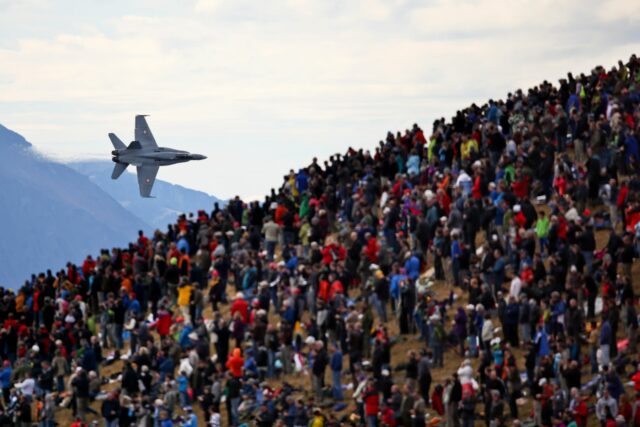ATC, Ambulance Needed, Accident Report and AXALP ’23
I have too many things I want to tell you about and not enough time to write them all so here’s a quick collection for you.
Two weeks ago, I wrote about the Bank Holiday chaos in the UK when the air traffic control sub-system failed.
There was a lively discussion and I’d like to recommend that you read the comments. You’ll find a lot more detail as to how the failure occurred, including the flight plan that kicked the whole thing off and a link to a great article by James Haydon which breaks down the software development issues very clearly: UK air traffic control meltdown.
Last week, an F-35 pilot ejected from his aircraft, an incident covered in detail by a number of news sites.
- What We Know About the Marine Corps F-35 Crash, Backyard Ejection and What Went Wrong by Tara Copp of Military.com
-
Why the missing F-35 was hard to find — and didn’t stray too far(https://breakingdefense.com/2023/09/why-a-missing-f-35-is-hard-to-find-but-probably-didnt-stray-too-far/) by Michael Marrow of Breaking Defense
-
Debris of US F-35 fighter jet found a day after pilot ejects from warplane in Al Jazeera
Today the audio from the 911 call was released. The phone call was made after the pilot and parachute landed in a family’s backyard, to everyone’s surprise.
Caller: We got a pilot at our house and he says he got ejected. He ejected from the plane. So yeah, we…just see if we can get an ambulance, please?
Emergency Services: I’m sorry… what happened?!
Pilot: We have a military jet crash. I’m the pilot. We need to get rescue rolling. I’m not sure where the airplane is.
I found this accident report while looking for something else in the ATSB database:
Embraer-Empresa Brasileira De Aeronautica EMB-110P1, VH-BWC
Sequence of events
At about 1659 Central Standard Time, on 29 November 2004, the right engine of an Embraer-Empresa Brasileira de Aeronutica, E110-P1 Banderiante, failed during the landing approach. The aircraft, registered VH-BWC, was being operated on a charter flight from Bathurst Island to Darwin, NT, with two crew and 18 passengers.
The two crew were the pilot and a cabin crew member.
The air traffic controller cleared the pilot to track via Lee Point for a right base for runway 29. The pilot reported that during the approach, about 6 NM from Darwin, he noticed that the right fuel pump warning light was flashing. Shortly after, the left fuel pump light flashed and he noticed that the fuel gauges were indicating empty. The pilot informed the controller that an engine was shutting down and requested and received a clearance to land on runway 18, which had about 5 kts downwind component. During the landing roll, the left engine also failed and both main landing gear tyres were damaged due to excessive brake application. There was no other damage and none of the occupants were injured.

The aircraft had run out of fuel, which made no sense, as the pilot had refueled at Darwin before the one hour flight to Bathurst Island.
The planned departure time from Darwin for the flight to Bathurst Island was 1600. At about 1500, the pilot ordered 450 lbs of fuel for the aircraft. The pilot held senior management responsibilities in the company and had been heavily distracted by those duties until after the planned departure time. He subsequently departed for Bathurst Island at 1610.
The refueller was delayed and did not arrive at the operator’s apron until after the aircraft had departed.
The captain, presuming that the aircraft had been refuelled, never checked the fuel quantity. Oops?
Finally, I’m beyond excited that I’m going to be attending the AXALP ’23 Air Force display next month! This is a flight display and live-firing exercise run by the Swiss Air Force every year.
The spectator areas are 2,200 metres amsl (7,200 feet) and although there’s a shuttle taking me from Briez to Axalp, I’ll be hiking the final 708 metres (2,320 feet). I cannot tell you how excited I am about this.
I’ve written about the details on my Substack newsletter but you can bet that I’ll be reporting back here to tell you all about it!
If you’ve ever been to this event, please let me know any tips and tricks! And if anyone would like to put in a good word with either the Swiss Air Force or the weather gods, I sure would appreciate it!










“The refueller was delayed and did not arrive at the operator’s apron until after the aircraft had departed.”
…And no one thought to call the pilot and warn him that he didn’t get his fuel??
Could they have called him? If he asked for fuel via radio, the refueler might have been working with a very low-power radio; if the fuel truck was more than a few minutes late, the plane might have been out of range. This sounds to me more like an example of carelessness in the preflight checks; “The pilot held senior management responsibilities in the company and had been heavily distracted by those duties” suggests that the old ANC rule (“aviate, navigate, communicate” — in that order) needs to be extended to ANCM (“manage”). Fortunately, this time the carelessness (not even looking at the gas gauges!) wasn’t fatal, unlike some of the other cases Sylvia has brought us.
Also: I understand that pilots even in not-so-small operations try not to carry excess fuel because the extra weight requires extra power (i.e., extra fuel) to carry. But this pilot shouldn’t have run out of fuel on this flight unless he was already into reserves by the time he got to Bathurst Island Airport. On Googlemaps this looks like a 50-mile flight to Darwin International Airport, in a plane whose 45-minute reserves are good for 159 miles at economy cruise. (Per Wikipedia’s data on the 18-passenger version of the EMB-110. Yes, climbing would burn fuel faster, and a flight this short wouldn’t have reached a fuel-efficient altitude — but would his average burn really have been three times the cruising-at-altitude burn?) I don’t know whether there was a followup Sylvia doesn’t mention, or flying in NT is just not as closely monitored; if this happened in the US, even on a “commuter” flight, I’d expect the FAA to have raised a red flag.
Obviously the refueler couldn’t call the aircraft from his truck radio. He would call his dispatcher, ground control, or the tower.
There’s a flight aloft with much less fuel than they think they have — and the refueler is the only person who knows it. He should spread the word.
I wondered about this but an alternative version is that the refueller believed that this was only a top up and so the pilot decided not to wait. I’m not sure that person would guess that the pilot thought that the tanks were full without ever checking the gauges.
Funnily enough, I actually contacted the ATSB on this to ask if there was a follow up or more detailed report or something. The person who checked the records even went back to their 2013 archives to check if there was a PDF or something that got lost along the way. But no, this is it. It was 20 years ago to be fair, but it really does strike me as awfully brief for what could have been a serious issue.